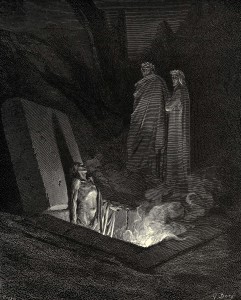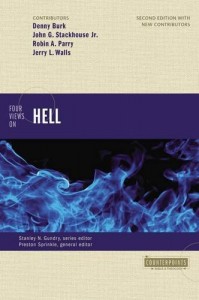Conscious in Death: A Response to Jerry Shepherd

Chris Date continues our dialogue on the duration of hell by responding to Jerry Shepherd's initial post, which argued for eternal conscious torment.

Professor Shepherd begins by arguing that death in the OT includes a disembodied conscious existence in Sheol awaiting resurrection. I needn’t contest that claim; from Saint Irenaeus to Professor Terrance Tiessen, many conditionalists have believed in a conscious intermediate state.[1] Nevertheless the OT’s “fundamental idea [of death] is the cessation of life”—God withdrawing the breath of life, causing one to return to the dust, cut off from the living (NIDOTTE)[2] —precisely that which the traditional view denies will happen to the risen lost.
Furthermore, Professor Shepherd seems to conflate a temporary situation—mere continuance of a soul after death—with a permanent one—a soul being immortal or eternally conscious. Plato may have held that persisting beyond corporeal death constitutes immortality, but Christians submitting to divine revelation know that the will of God determines how long a person will consciously endure. If the soul lives on after the body’s first death (Matt 10:28; Jas 2:26), God can still destroy it with the body in the second (Matt 10:28).
INTERTESTAMENTAL LITERATURE Most intertestamental literature, alleges Professor Shepherd, depicts final punishment as eternal torment. Lacking specific citations, his claim is difficult to evaluate. Meanwhile, the late E. Earle Ellis of Southwestern Baptist Theological Seminary wrote that both eternal torment and annihilation views frequent the intertestamental literature.[3] Most scholars who specialize in this material agree. David Instone-Brewer, a scholar in ancient Judaism at Tyndale House, Cambridge, argues that Jesus’ language and that of contemporaneous rabbinic writings had been used in “all extant early non-rabbinic Jewish sources” to communicate final annihilation after a period of suffering.[4]
ETERNAL LIFE AND PUNISHMENT I simply agree that in Matthew 25:46, aiōnios means the same thing both in “eternal punishment” and “eternal life”: they are equally everlasting. It does not follow that here “‘punishment’ and ‘life’ are two continuing states having to do with conscious individuals.” Eternal punishment needn’t imply an everlasting process of punishing any more than “eternal redemption” in Hebrews 9:12 implies an everlasting process of redeeming.
The adjective aiōnios makes life and punishment parallel in duration, but the judicial context makes them mutually exclusive in nature: only the righteous will be granted eternal life. The fate of the lost is therefore death forever—eternal capital punishment. And as Augustine noted, capital punishment is inflicted quickly, but its duration greatly exceeds that of one’s crimes, being measured in how long one remains dead.[5] Even Jonathan Edwards admitted that annihilation qualifies as an eternal punishment.[6]
MAGGOTS AND FIRE Professor Shepherd argues that the undying worm and unquenchable fire in Isaiah 66:24 indirectly refer to eternal torment. In reality, these phrases and ideas communicate irresistible—and thus complete—consumption (Ezek 20:47–48; Jer 17:27; Amos 5:6; Deut 28:26; Jer 7:33). Far from being “banal” and lacking gravitas, in Hebrew thought the consumption of one’s corpse by fire and scavengers was, as noted by traditionalist Robert Peterson, “a sign of contempt” and “a great disgrace” (cf. Dan 12:2).[7]
Yes, Judith appears to have transformed Isaiah’s scene of corpses being consumed by fire and maggots into a scene of living people suffering forever, but this was just one among competing views of final punishment. Had Jesus intended to evoke Judith’s understanding, he could have easily quoted it, or said something like it, but chose instead to quote Isaiah.
REVELATION AND THE SECOND DEATH I agree with Professor Shepherd that Revelation 14:9–11 and 20:10 apparently depict eternal torment. It does not follow, however, that “these descriptions should take hermeneutical precedence over against arguments that are more narrowly based on a literal understanding of lexical terms like ‘death’ and ‘destruction.’” Revelation is notoriously the most difficult book of the Bible to interpret, with its often bizarre, apocalyptic symbolism. Meanwhile, the biblical language of final destruction appears in straightforward, didactic contexts (e.g. Rom 6:23; John 3:16), and when historical examples are offered which illustrate the meaning of the language used (e.g. 2 Pet 2:6; Jude 7). An accepted hermeneutical principle is to interpret unclear passages in light of clear ones, a principle Professor Shepherd appears to apply in reverse.[8]

Besides, this imagery in Revelation is, as I explained in my opening, better support for conditionalism. Professor Shepherd correctly notes that John sees the lost thrown into the same lake of fire in which the devil, beast, and false prophet are tormented forever. So too, however, are death and Hades (v. 14), earlier depicted as sentient horsemen (6:7) and thus capable of torment in the imagery. In the more straightforward and didactic 1 Corinthians 15, Paul says death will be “destroyed” at the resurrection (v. 26; cf. v. 23–24, 54), katargeō meaning “to cause to cease to happen” or “to render inoperative.”[9] Although presumably tormented in the imagery, then, the fate in reality of death and Hades is annihilation: after all of God’s enemies have been destroyed and his people made immortal, no one will ever die again. As God says from the throne in Revelation 21:4, “death shall be no more.” If consistency demands the same fate for human beings, that fate is likewise annihilation.
Further, the interpretation Scripture offers of its own imagery is necessarily clearer in meaning than the imagery itself. Were this not the case, what was meant by the dreams of Pharaoh and Nebuchadnezzar would be lost to them (and to us!). The seven cows in Pharaoh’s dream, Joseph said, “are seven years” (Gen 41:26); the tree in Nebuchadnezzar’s dream, Daniel said, “is you, O king” (Dan 4:20–22). John and God follow in this interpretive tradition, saying Revelation’s lake of fire “is the second death” (21:8; 20:14). The second death is not another symbol, metaphor, or figure of speech; it is the plain, straightforward interpretation of the otherwise perplexing imagery: the resurrected lost will literally die a second time.
CONCLUSION Fifteen hundred words is not many; I completely understand that given a greater word limit, Professor Shepherd could have offered a more substantial case for his view. Still, in over 1,750 words he presented little actual evidence for his view. The evidence Professor Shepherd did present, as we have now seen, does not hold up to scrutiny.
Meanwhile, I cited numerous biblical texts that teach the lost will finally die, perish, and be destroyed; that immortality is a gift God will grant only to the saved; that the Lord died a vicarious, substitutionary death in the place of those who accept it, implying those who reject it will suffer that fate themselves; and that the Bible nowhere teaches that the unsaved will instead be made immortal to endure eternal life in torment.
Footnotes
[1] Irenaeus, Against Heresies 2.34.3, said life “is bestowed according to the grace of God,” and whereas the saved “shall receive also length of days for ever and ever,” the lost instead “deprives himself of continuance for ever and ever” and “shall justly not receive from Him length of days for ever and ever.” Tiessen sketches his adoption of conditionalism in Terrance L. Tiessen, “My Long Journey to Annihilationism,” A Consuming Passion: Essays on Hell and Immortality in Honor of Edward Fudge (Eugene, OR: Pickwick, 2015), 17–31.
[2] Eugene H. Merrill, “מוּת,” in New International Dictionary of Old Testament Theology & Exegesis, ed. Willem A. VanGemeren (Grand Rapids, MI: Zondervan, 1997), 886, 888.
[3] E. Earle Ellis, “New Testament Teaching on Hell,” in Rethinking Hell: Readings in Evangelical Conditionalism, eds. Christopher M. Date, Gregory G. Stump, and Joshua W. Anderson (Eugene, OR: Cascade, 2014), 123. Ellis offers Judith 16:17 (“they shall cry in consciousness forever”) as an example of intertestamental literature teaching eternal torment, and as an example teaching annihilation he offers 1 Enoch 98:10 (“do not hope that you will live . . . rather you will go and die”) and 4Q418 69:7f (“All the crazy at heart will be annihilated, and the sons of iniquity will be found no more”).
[4] David Instone-Brewer, “Eternal Punishment in First-Century Jewish Thought,” in A Consuming Passion: Essays on Hell and Immortality in Honor of Edward Fudge, eds. Christopher M. Date and Ron Highfield (Eugene, OR: Pickwick, 2015), 224; emphasis added. Instone-Brewer cites 1 Enoch 10:13–15; 91:1; Jubilees 36:10; CD 2.6; 1QS 2.15; 4.14; 5.13; 1QHa 14.21; and others.
[5] City of God 21.11.1.
[6] Jonathan Edwards, The Works of Jonathan Edwards, vol. 2 (Banner of Truth Trust, 1974), 524.
[7] Edward William Fudge and Robert A. Peterson, Two Views of Hell: A Biblical & Theological Dialogue (Downers Grove, IL: IVP Academic, 2000), 132.
[8] See, for example: Dan McCartney and Charles Clayton, Let the Reader Understand: A Guide to Interpreting and Applying the Bible, 2nd ed. (Phillipsburg, NJ: Presbyterian & Reformed, 2002),170; David E. O’Brien, Today’s Handbook for Solving Bible Difficulties (Minneapolis, MN: Bethany House, 1990), 183; Kenneth Boa, Cults, World Religions and the Occult (Colorado Springs, CO: Victor Books, 12; and C. Powell, “A stalemate of genders? Some hermeneutical reflections,” Themelios 17, no. 3 (April/May, 1992), 17.
[9] Johannes P. Louw and Eugene Albert Nida, Greek-English Lexicon of the New Testament: Based on Semantic Domains (New York, NY: United Bible Societies, 1996), 165; Robert L. Thomas, New American Standard Hebrew-Aramaic and Greek Dictionaries, updated ed. (Anaheim, CA: Foundation Publications, Inc., 1998), s.v. καταργέω.





